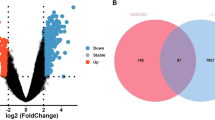Abstract
Alzheimer’s disease (AD) is a neurodegenerative disorder partly induced by dysregulation of different brain regions. Prefrontal cortex (PFC) dysregulation has been reported to associate with mental symptoms such as delusion, apathy, and depression in AD patients. However, the internal mechanisms have not yet been well-understood. This study aims to identify the potential therapeutic target genes and related pathways in PFC of AD. First, differential expression analyses were performed on transcriptome microarray of PFC between AD specimens and non-AD controls. Second, protein–protein interaction networks were constructed based on the identified differentially expressed genes to explore candidate therapeutic target genes. Finally, these candidate genes were validated through biological experiments. The enrichment analyses showed that the differentially expressed genes were significantly enriched in protein functions and pathways related to AD. Furthermore, the top ten hub genes in the protein–protein interaction network (ELAVL1, CUL3, MAPK6, FBXW11, YWHAE, YWHAZ, GRB2, CLTC, YWHAQ, and PDHA1) were proved to be directly or indirectly related to AD. Besides, six genes (PDHA1, CLTC, YWHAE, MAPK6, YWHAZ, and GRB2) of which were validated to significantly altered in AD mice by biological experiments. Importantly, the most significantly changed gene, PDHA1, was proposed for the first time that may be serve as a target gene in AD treatment. In summary, several genes and pathways that play critical roles in PFC of AD patients have been uncovered, which will provide novel insights on molecular targets for treatment and diagnostic biomarkers of AD.






Similar content being viewed by others
References
Gao H, Tao Y, He Q, Song F, Saffen D (2015) Functional enrichment analysis of three Alzheimer’s disease genome-wide association studies identities DAB1 as a novel candidate liability/protective gene. Biochem Biophys Res Commun 463(4):490–495. https://doi.org/10.1016/j.bbrc.2015.05.044
Chang WS, Wang YH, Zhu XT, Wu CJ (2017) Genome-wide profiling of miRNA and mRNA expression in Alzheimer’s disease. Med Sci Monit 23:2721–2731
Chandrasekaran S, Bonchev D (2016) Network topology analysis of post-mortem brain microarrays identifies more alzheimer’s related genes and MicroRNAs and points to novel routes for fighting with the disease. PLoS One 11(1):e0144052. https://doi.org/10.1371/journal.pone.0144052
Pang X, Zhao Y, Wang J, Zhou Q, Xu L, Kang Liu AL, Du GH (2017) The Bioinformatic analysis of the dysregulated genes and MicroRNAs in entorhinal cortex, hippocampus, and blood for alzheimer’s disease. Biomed Res Int 2017:9084507. https://doi.org/10.1155/2017/9084507
Tompary A, Davachi L (2017) Consolidation promotes the emergence of representational overlap in the hippocampus and medial prefrontal cortex. Neuron 96(1):228–241. https://doi.org/10.1016/j.neuron.2017.09.005
Bekinschtein P, Weisstaub N (2014) Role of PFC during retrieval of recognition memory in rodents. J Physiol Paris 108(4–6):252–255. https://doi.org/10.1016/j.jphysparis.2014.03.001
Balderston NL, Vytal KE, O’Connell K, Torrisi S, Letkiewicz A, Ernst M, Grillon C (2017) Anxiety patients show reduced working memory related dlPFC activation during safety and threat. Depress Anxiety 34(1):25–36. https://doi.org/10.1002/da.22518
Feld M, Krawczyk MC, Fustinana MS, Blake MG, Baratti CM, Romano A, Boccia MM (2014) Decrease of ERK/MAPK overactivation in prefrontal cortex reverses early memory deficit in a mouse model of Alzheimer’s disease. J Alzheimers Dis 40(1):69–82
Leshikar ED, Leach RC, McCurdy MP, Trumbo MC, Sklenar AM, Frankenstein AN, Matzen LE (2017) Transcranial direct current stimulation of dorsolateral prefrontal cortex during encoding improves recall but not recognition memory. Neuropsychologia 106:390–397. https://doi.org/10.1016/j.neuropsychologia.2017.10.022
Ribeiro EA, Scarpa JR, Garamszegi SP, Kasarskis A, Mash DC, Nestler EJ (2017) Gene network dysregulation in dorsolateral prefrontal cortex neurons of humans with cocaine use disorder. Sci Rep 7(1):5412. https://doi.org/10.1038/s41598-017-05720-3
Tei S, Fujino J, Kawada R, Jankowski KF, Kauppi JP, van den Bos W, Abe N, Sugihara G, Miyata J, Murai T, Takahashi H (2017) Collaborative roles of temporoparietal junction and dorsolateral prefrontal cortex in different types of behavioural flexibility. Sci Rep 7(1):6415. https://doi.org/10.1038/s41598-017-06662-6
Liang B, Li CN, Zhao JY (2016) Identification of key pathways and genes in colorectal cancer using bioinformatics analysis. Med Oncol 33(10):111
Blue EE, Bis JC, Dorschner MO, Tsuang DW, Barral SM, Beecham G, Below JE, Bush WS, Butkiewicz M, Cruchaga C, DeStefano A, Farrer LA, Goate A, Haines J, Jaworski J, Jun G, Kunkle B, Kuzma A, Lee JJ, Lunetta KL, Ma YY, Martin E, Naj A, Nato AQ, Navas P, Nguyen H, Reitz C, Reyes D, Salerno W, Schellenberg GD, Seshadri S, Sohi H, Thornton TA, Valadares O, van Duijn C, Vardarajan BN, Wang LS, Boerwinkle E, Dupuis J, Pericak-Vance MA, Mayeux R, Wijsman EM, Project AsDS (2018) Genetic variation in genes underlying diverse dementias may explain a small proportion of cases in the Alzheimer’s disease sequencing project. Dement Geriatr Cogn 45(1–2):1–17
Cao Y, Zhang D, Zhou H (2019) Key genes differential expressions and pathway involved in salt and water-deprivation stresses for renal cortex in camel. BMC Mol Biol 20(1):11. https://doi.org/10.1186/s12867-019-0129-8
Hokama M, Oka S, Leon J, Ninomiya T, Honda H, Sasaki K, Iwaki T, Ohara T, Sasaki T, LaFerla FM, Kiyohara Y, Nakabeppu Y (2014) Altered expression of diabetes-related genes in Alzheimer’s disease brains: the Hisayama study. Cereb Cortex 24(9):2476–2488. https://doi.org/10.1093/cercor/bht101
Gautier L, Cope L, Bolstad BM, Irizarry RA (2004) affy–analysis of Affymetrix GeneChip data at the probe level. Bioinformatics 20(3):307–315. https://doi.org/10.1093/bioinformatics/btg405
de la Fuente A (2010) From ‘differential expression’ to ‘differential networking’—identification of dysfunctional regulatory networks in diseases. Trends Genet 26(7):326–333. https://doi.org/10.1016/j.tig.2010.05.001
Chang RY, Nouwens AS, Dodd PR, Etheridge N (2013) The synaptic proteome in Alzheimer’s disease. Alzheimers Dement 9(5):499–511. https://doi.org/10.1016/j.jalz.2012.04.009
Sri S, Pegasiou CM, Cave CA, Hough K, Wood N, Gomez-Nicola D, Deinhardt K, Bannerman D, Perry VH, Vargas-Caballero M (2019) Emergence of synaptic and cognitive impairment in a mature-onset APP mouse model of Alzheimer’s disease. Acta Neuropathol Commun 7(1):25. https://doi.org/10.1186/s40478-019-0670-1
Scheckel C, Drapeau E, Frias MA, Park CY, Fak J, Zucker-Scharff I, Kou Y, Haroutunian V, Ma’ayan A, Buxbaum JD, Darnell RB (2016) Regulatory consequences of neuronal ELAV-like protein binding to coding and non-coding RNAs in human brain. Elife. https://doi.org/10.7554/eLife.10421
Burry RW, Smith CL (2006) HuD distribution changes in response to heat shock but not neurotrophic stimulation. J Histochem Cytochem 54(10):1129–1138. https://doi.org/10.1369/jhc.6A6979.2006
Chauhan N, Chaunsali L, Deshmukh P, Padmanabhan B (2013) Analysis of dimerization of BTB-IVR domains of Keap1 and its interaction with Cul3, by molecular modeling. Bioinformation 9(9):450–455. https://doi.org/10.6026/97320630009450
Mitsuishi Y, Motohashi H, Yamamoto M (2012) The Keap1-Nrf2 system in cancers: stress response and anabolic metabolism. Front Oncol 2:200. https://doi.org/10.3389/fonc.2012.00200
McMahon M, Thomas N, Itoh K, Yamamoto M, Hayes JD (2004) Redox-regulated turnover of Nrf2 is determined by at least two separate protein domains, the redox-sensitive Neh2 degron and the redox-insensitive Neh6 degron. J Biol Chem 279(30):31556–31567. https://doi.org/10.1074/jbc.M403061200
Calkins MJ, Johnson DA, Townsend JA, Vargas MR, Dowell JA, Williamson TP, Kraft AD, Lee JM, Li J, Johnson JA (2009) The Nrf2/ARE pathway as a potential therapeutic target in neurodegenerative disease. Antioxid Redox Signal 11(3):497–508. https://doi.org/10.1089/ARS.2008.2242
Kim YS, Choi MY, Kim YH, Jeon BT, Lee DH, Roh GS, Kang SS, Kim HJ, Cho GJ, Choi WS (2010) Protein kinase Cdelta is associated with 14-3-3 phosphorylation in seizure-induced neuronal death. Epilepsy Res 92(1):30–40. https://doi.org/10.1016/j.eplepsyres.2010.08.004
Wang L, Chiang HC, Wu W, Liang B, Xie Z, Yao X, Ma W, Du S, Zhong Y (2012) Epidermal growth factor receptor is a preferred target for treating amyloid-beta-induced memory loss. Proc Natl Acad Sci USA 109(41):16743–16748. https://doi.org/10.1073/pnas.1208011109
Wang L, Liang B, Zhong Y (2013) Reduced EGFR level potentially mediates the Abeta42-induced neuronal loss in transgenic fruit fly and mouse. Protein Cell 4(9):647–649. https://doi.org/10.1007/s13238-013-3043-8
Kornitzer D, Ciechanover A (2000) Modes of regulation of ubiquitin-mediated protein degradation. J Cell Physiol 182(1):1–11. https://doi.org/10.1002/(SICI)1097-4652(200001)182:1%3c1:AID-JCP1%3e3.0.CO;2-V
Winston JT, Koepp DM, Zhu C, Elledge SJ, Harper JW (1999) A family of mammalian F-box proteins. Curr Biol 9(20):1180–1182. https://doi.org/10.1016/S0960-9822(00)80021-4
Skaar JR, Pagan JK, Pagano M (2013) Mechanisms and function of substrate recruitment by F-box proteins. Nat Rev Mol Cell Biol 14(6):369–381. https://doi.org/10.1038/nrm3582
Cardozo T, Pagano M (2004) The SCF ubiquitin ligase: insights into a molecular machine. Nat Rev Mol Cell Biol 5(9):739–751. https://doi.org/10.1038/nrm1471
Jucker M, Walker LC (2013) Self-propagation of pathogenic protein aggregates in neurodegenerative diseases. Nature 501(7465):45–51. https://doi.org/10.1038/nature12481
Juenemann K, Jansen AHP, van Riel L, Merkx R, Mulder MPC, An H, Statsyuk A, Kirstein J, Ovaa H, Reits EA (2018) Dynamic recruitment of ubiquitin to mutant huntingtin inclusion bodies. Sci Rep 8(1):1405. https://doi.org/10.1038/s41598-018-19538-0
Ho Kim J, Franck J, Kang T, Heinsen H, Ravid R, Ferrer I, Hee Cheon M, Lee JY, Shin Yoo J, Steinbusch HW, Salzet M, Fournier I, Mok Park Y (2015) Proteome-wide characterization of signalling interactions in the hippocampal CA4/DG subfield of patients with Alzheimer’s disease. Sci Rep 5:11138. https://doi.org/10.1038/srep11138
Sluchanko NN, Seit-Nebi AS, Gusev NB (2009) Effect of phosphorylation on interaction of human tau protein with 14-3-3zeta. Biochem Biophys Res Commun 379(4):990–994. https://doi.org/10.1016/j.bbrc.2008.12.164
Lin S, Lin Y, Nery JR, Urich MA, Breschi A, Davis CA, Dobin A, Zaleski C, Beer MA, Chapman WC, Gingeras TR, Ecker JR, Snyder MP (2014) Comparison of the transcriptional landscapes between human and mouse tissues. P Natl Acad Sci USA 111(48):17224–17229
Miki Y, Tanji K, Mori F, Kakita A, Takahashi H, Wakabayashi K (2017) Alteration of mitochondrial protein PDHA1 in Lewy body disease and PARK14. Biochem Bioph Res Co 489(4):439–444
Acknowledgements
We would like to thank Dr. Shen for his constructive suggestions on our statistical analysis. This paper has been accepted by the 4th CCF Bioinformatics Conference (CBC2019).
Funding
This work was partially supported by the National Natural Science Foundation of China (No. 61873156), and the Project of Natural Science Foundation of Shanghai (No. 17ZR1409900).
Author information
Authors and Affiliations
Corresponding author
Ethics declarations
Conflict of Interest
The authors have declared that no competing interests exist.
Rights and permissions
About this article
Cite this article
Yang, F., Diao, X., Wang, F. et al. Identification of Key Regulatory Genes and Pathways in Prefrontal Cortex of Alzheimer’s Disease. Interdiscip Sci Comput Life Sci 12, 90–98 (2020). https://doi.org/10.1007/s12539-019-00353-8
Received:
Revised:
Accepted:
Published:
Issue Date:
DOI: https://doi.org/10.1007/s12539-019-00353-8




